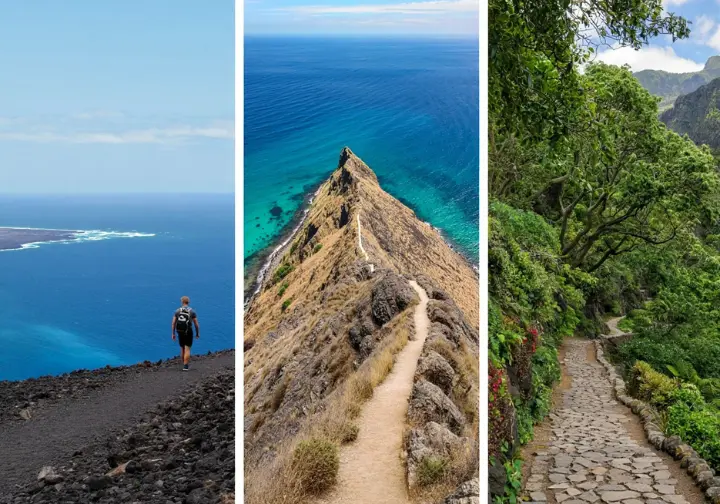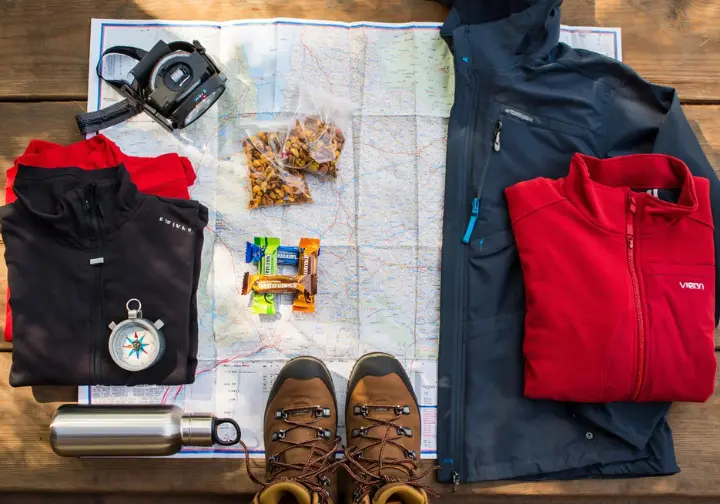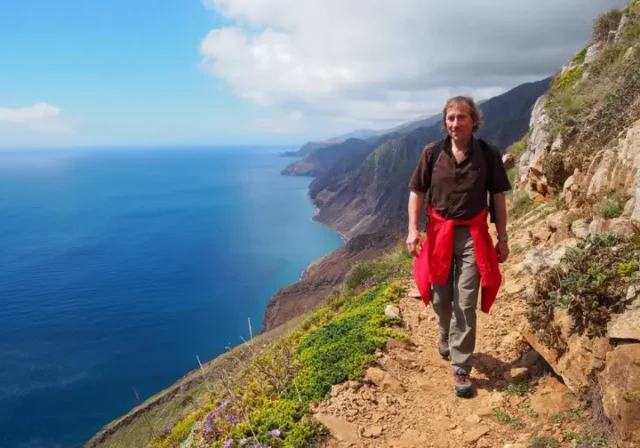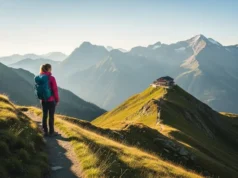In this article
Thinking about hiking in Europe in March? It’s a time of transition, a shoulder season where winter’s grip loosens, and the first hints of spring emerge. This article explores why March can be a fantastic, albeit challenging, time for a hike, delves into the best regions to target, and outlines the essential preparation needed for a successful adventure.
We’ll navigate the advantages of fewer crowds and awakening landscapes, understand the crucial variability of March weather, pinpoint prime destinations from sunny islands to coastal trails, and map out the gear and planning required. Let’s chart a course for your early spring European hiking journey.
Why Hike Europe in March?

March presents a unique window for hiking in Europe. It’s a time characterized by quieter trails and nature stirring back to life, especially in southern regions. However, this shoulder season demands respect; variable weather and lingering winter conditions require thoughtful planning to navigate the path safely and enjoyably.
The Early Spring Advantage
One of the most compelling reasons for hiking in March Europe offers is the chance to beat the crowds. Popular trails and destinations are noticeably quieter than during the summer rush. Imagine walking iconic coastal paths or island hikes with a sense of serenity, allowing for deeper immersion in nature without the usual bustle. We know that feeling of having a beautiful vista almost to yourself – it’s a rare treat later in the year.
While unpredictable, March often brings pleasant temperatures for active pursuits, particularly in Southern Europe and the Mediterranean islands. Destinations like the Canary Islands can boast average highs around 22°C (72°F), offering comfortable walking conditions that contrast sharply with potential summer heatwaves. Strategic location choice is key here.
This month truly allows you to witness nature awakening. Landscapes begin shedding their winter coats, with trees budding and early wildflowers adding splashes of color, especially at lower elevation levels. In regions like Mallorca, you might even catch the tail end of the almond blossom season, adding unique beauty to your hike. Observing this seasonal shift is a distinct visual reward.
Beyond the scenery, there’s the potential for lower costs. Travel and accommodation can sometimes be more budget-friendly during this shoulder period compared to peak season. A little research into flights and lodging might reveal welcome savings for your adventure.
The softer light of early spring, combined with potentially dramatic skies and emerging greenery, creates unique photographic opportunities. Fewer people also mean cleaner landscape shots. The contrast between lingering snow on distant mountain peaks and green valleys below can be particularly striking for outdoor enthusiasts with a camera.
Finally, March serves as an excellent testing ground for gear. For hikers planning longer treks later in the year, it’s a perfect chance to test layering systems and equipment in variable conditions. Encountering sun, rain, and wind, perhaps all on the same hike, helps refine your packing list and builds confidence. Ensuring your essential hiking gear is up to scratch before a bigger trip is invaluable.
Understanding March Variability
The primary challenge of hiking in March Europe presents is unpredictable weather. As a transitional month, conditions can swing rapidly from mild sunshine to cold rain and biting wind, sometimes in a matter of hours. Relying solely on averages isn’t enough; preparation for a range of conditions is essential. Have you ever been caught out by a sudden spring downpour? Proper layering is your best defense.
Snow remains a factor, especially away from southern coasts. Higher elevations, even in regions like southern Spain or Italy, and most mid-to-high altitude trails further north (like the Alps or Pyrenees) will likely still have significant snow cover. Researching snow lines and choosing routes accordingly is vital. Assuming a trail is clear simply based on latitude is a common mistake; avoid alpine terrain unless you have winter equipment and experience.
Increased rainfall and thawing ground often lead to mud and wet trails, particularly in forests or areas without rocky paths. Sturdy, waterproof hiking boots with excellent tread are non-negotiable. We’ve all experienced that sinking feeling – both literally and figuratively – on a boggy trail. Be prepared for slower progress and consider gaiters to keep debris out.
Be aware that trail closures are possible. Some routes, especially high-altitude mountain passes or paths prone to damage (like coastal sections or gorges), might remain closed for maintenance or due to hazards like snowmelt or rockfall. The famous Samaria Gorge in Crete, for instance, typically opens later in spring, usually May. Always check official park or trail websites for the latest status updates before setting off.
Access to facilities can also be limited. Outside the main season, some mountain huts, cafes, shops, and even public transport services might operate on reduced schedules or be closed entirely. Plan self-sufficiency by carrying enough food and water, and verify operating hours beforehand. Booking accommodation ahead is often wise, especially on multi-day treks.
While daylight hours are increasing, they are still shorter than in summer. Plan your hikes to finish comfortably before dusk. Always carry a reliable headlamp or torch, just in case of delays. Factoring in the available daylight is a crucial part of safe route planning for any hiker.
Top Regions for March Hiking

The sweet spot for hiking in Europe in March generally lies in Southern Europe, Mediterranean islands, and specific coastal or lower-altitude areas further north. These regions offer the best balance of potentially milder weather and accessible trails, steering clear of the lingering deep snow found in higher mountain ranges like the Alps.
Iberian Peninsula Sunshine
The Canary Islands (Spain) are perhaps the most reliable bet for warmth. Islands like Tenerife, Gran Canaria, La Gomera, and La Palma offer vast networks of trails through diverse volcanic landscapes, laurel forests, and stunning coastal areas. March avoids peak summer heat, ideal for tackling sections of the GR131 long trail or exploring Teide National Park. Just be mindful of altitude changes affecting temperature.
Madeira (Portugal), the “island of eternal spring,” is famed for its unique levada trails. These irrigation channels carve paths through lush, subtropical scenery and along dramatic cliffs. While the highest peaks might still present challenges, numerous lower and mid-altitude levadas are perfect for March hiking. Always check local notices, as paths can close temporarily for maintenance.
Along Portugal’s Algarve Coast, the Fisherman’s Trail section of the Rota Vicentina offers world-class coastal walking. March sees fewer crowds, allowing for peaceful enjoyment of stunning cliff-top views and sandy paths connecting charming villages. Temperatures are generally mild, but planning water stops and potentially using gaiters for sandy sections is wise.
In Mallorca (Spain), the Serra de Tramuntana mountains (a UNESCO site) provide challenging hikes on the GR221 Dry Stone Route. This trail winds through dramatic limestone terrain and picturesque villages. March can bring pleasant temperatures and the beauty of late almond blossoms, though be prepared for rain and cooler conditions higher up.
Mainland Spain’s Andalusia offers diverse options. Consider coastal walks in Cabo de Gata Natural Park (ideal in cooler months) or trails in the Sierra de Aracena. Lower elevation sections of routes like the Camino de Santiago (e.g., Camino Mozárabe) are also viable. Inland areas can still be cool, so check local forecasts.
Near Lisbon, Arrábida Natural Park (Portugal) provides beautiful coastal and forested trails often overlooked. It’s a less crowded alternative to the Algarve, offering scenic beauty and comfortable spring walking conditions close to the capital. Exploring paths leading to hidden beaches here is a rewarding experience.
Mediterranean Island Escapes
While Crete’s famous Samaria Gorge is typically closed until May, Crete (Greece) offers numerous other hiking opportunities in March. Focus on the southern coast and lower-altitude gorges to enjoy rugged landscapes, ancient sites, and emerging wildflowers in pleasant temperatures. Be ready for potential rain and wind, especially earlier in the month.
Cyprus boasts abundant sunshine, making it excellent for March hiking. Explore the Akamas Peninsula’s coastal paths or lower trails in the Troodos Mountains. Pine forests, historical villages, and turquoise waters await before the intense summer heat arrives. Conditions are generally favourable, though some rain is possible.
The compact islands of Malta & Gozo offer accessible coastal walking past dramatic cliffs, megalithic temples, and fortified towns. The Gozo Coastal Walk is a highlight, easily navigated in mild March weather. It’s perfect for combining relatively easy hiking with rich cultural exploration.
Sicily (Italy) presents diverse terrain, from coastal trails in reserves like Zingaro to routes on the lower slopes of Mount Etna (higher parts may require snow gear). Sections of the ancient Via Francigena pilgrimage route also cross the island. March offers a good balance before summer heat makes hiking more strenuous.
Sardinia (Italy) lures trekkers with its rugged, wild landscapes, especially on the eastern coast (Orosei Gulf) and interior. While famous routes like the Selvaggio Blu are demanding multi-day undertakings often requiring guides, numerous other coastal and inland paths showcase Sardinia’s beauty under more manageable March conditions.
Beyond the larger islands, other Greek Islands like Naxos, Amorgos, or Corfu (with its Corfu Trail) offer potential for March hiking, particularly on coastal and lower-level routes. Remember that ferry schedules might be reduced compared to summer, so plan inter-island travel carefully and check local resources for trail accessibility.
Coastal & Lowland Gems
The iconic Amalfi Coast & Cinque Terre (Italy) boast stunning coastal paths like the ‘Path of the Gods’. March means fewer crowds and less heat, but be aware that sections, especially in Cinque Terre, can close due to weather damage or maintenance. Always check the current trail status locally before setting out. What’s your favorite Italian coastal view?
Near Marseille, Calanques National Park (France) features spectacular fjord-like inlets with turquoise waters and white limestone cliffs. Spring (including March) is often cited as the prime time to hike here, avoiding summer heat and potential fire closures. Trails range from easy strolls to more demanding climbs.
While not typically warm, UK Coastal Paths like the South West Coast Path (Cornwall), Pembrokeshire Coast Path (Wales), or Jurassic Coast (Dorset) offer dramatic scenery and are generally accessible year-round. Be prepared for wind and rain, but enjoy the rugged beauty as winter recedes. Lower fells in the Lake District also start opening up.
Ticino (Switzerland), the Italian-speaking canton, enjoys a milder climate than regions north of the Alps. This makes it a viable March option for hiking trails around Lake Lugano or Lake Maggiore. Enjoy mountain views and lakeside paths, often snow-free at lower elevations, offering alpine beauty with a Mediterranean feel.
In Slovenia, lower-altitude areas like the Soča Valley or trails around Lake Bohinj and Lake Bled offer stunning scenery within the Julian Alps foothills. While high peaks remain snow-bound, valley trails and sections of routes like the Juliana Trail or Alpe-Adria Trail can be accessible, showcasing Slovenia’s natural beauty. Check conditions locally, especially for river crossings. Using a reliable hiking app can help with planning and checking recent conditions in these areas.
Preparing for Hiking in Europe in March

Success on a March hike in Europe hinges on meticulous preparation. This means selecting versatile gear suitable for unpredictable weather, undertaking careful route planning using reliable, current information, and anticipating potential logistical hurdles common during the shoulder season.
Essential Gear Checklist
A layering system is key. Pack moisture-wicking base layers (merino wool or synthetics – never cotton!), insulating mid-layers (like fleece or a light puffy jacket), and a reliable waterproof and windproof outer shell jacket and trousers. This allows you to adapt to fluctuating temperatures and stay comfortable whether the sun shines or the wind bites. Getting the layers right is fundamental.
Waterproof footwear is crucial. Choose well broken-in, waterproof hiking boots with good ankle support and sturdy tread. You’ll likely encounter mud, puddles, or even slush. Wet feet lead to blisters and misery, so prioritize keeping them dry. Consider quality hiking socks designed for moisture management as well – they make a huge difference. Selecting the right type of hiking boot for the conditions is paramount.
Navigation tools are mandatory. Don’t rely solely on your phone, as batteries die and signals drop. Carry a physical map and compass (and know the basics of using them) as essential backups. Supplement these with a GPS device or a smartphone loaded with downloaded offline maps for your chosen trails. Always carry a portable power bank.
Plan your hydration and nutrition carefully. Carry sufficient water, as natural sources might be scarce or require treatment (consider a filter/purifier). Cafes or shops along the trail could be closed, so pack high-energy snacks and extra food, especially for longer hikes. Underestimating supply needs is a common pitfall.
Sun protection is needed, even on cool or cloudy days. UV levels can be surprisingly strong, especially at higher elevation or near water. Pack high-SPF sunscreen, sunglasses offering UV protection, and a suitable hat (wide-brimmed for sun, warm beanie for cold/wind). Don’t forget this, even if it doesn’t feel ‘hot’.
Carry a basic first-aid kit tailored for hiking, including blister care essentials (moleskin, antiseptic wipes, tape). A headlamp or torch with extra batteries is non-negotiable for safety. Trekking poles are highly recommended; they provide stability on slippery terrain and reduce strain on your knees during descents.
Consider packing gaiters. Especially for muddy trails or routes with loose scree or sand (like parts of Portugal’s Fisherman’s Trail), low gaiters are brilliant for preventing debris from getting into your hiking boots. It’s a small item that significantly boosts comfort when conditions demand it. A good waterproof rain jacket is also essential for unpredictable March weather.
Finding Reliable Information
Prioritize official sources. National Park websites, regional tourism boards (like Visit Madeira’s walker updates), and official trail management bodies offer the most authoritative information. Check them for current trail status, closures, safety alerts (like Samaria Gorge opening dates), and regulations before and during your trip.
Consult recent trip reports, but with caution. Moderated forums (like Reddit’s r/hiking or Fodor’s) and reputable hiking blogs offer valuable, timely insights from fellow hikers. However, always cross-reference anecdotal information about trail conditions or logistics with official sources for confirmation. User reports provide clues, not definitive answers.
Use specialized hiking apps wisely. Apps like Komoot, AllTrails, or Gaia GPS often feature user comments and condition updates. These can be helpful for gauging recent status, especially if official updates are infrequent. Remember to download offline maps, as mobile signal is often unreliable in mountain or remote coastal areas.
Check local weather forecasts diligently. Use reliable meteorological services providing detailed forecasts for specific mountain or coastal regions, not just general city summaries. Look for precipitation probability, wind speed/direction, freezing levels, and temperature variations at different altitudes. Consulting multiple sources gives a better picture.
Contact local experts if possible. Guesthouse owners, hotel staff near trailheads, or local tourist information offices often possess valuable, up-to-the-minute knowledge about nearby trail conditions. Don’t hesitate to ask upon arrival – local insight can be invaluable.
Specifically look for shoulder season specifics in your research. General guidebooks often focus on peak summer conditions, which may not apply in March. Seek out resources, articles, or forum discussions that explicitly address the unique challenges and opportunities of hiking during this transitional spring period.
Navigating Potential Hurdles
Plan for transport gaps. Public transport schedules (buses, trains, ferries) may be significantly reduced in March compared to summer. Research timetables specific to March well in advance via official provider websites. Have backup plans, like taxi numbers or pre-booked transfers, especially for reaching remote trailheads.
Book accommodation early, particularly for multi-day treks or in areas with limited options. While less crowded than summer, popular spots can still fill up, especially if some establishments remain closed for the season. Confirm your bookings closer to the date and let them know your estimated arrival time.
Maintain flexibility in your itinerary. Build in contingency days or identify shorter, alternative route options. Bad weather, unexpected trail closures, or transport issues can easily disrupt rigid plans. Having backup options allows you to adapt gracefully without the whole trip falling apart. Don’t overschedule!
Be cautious with water crossings. Snowmelt from higher elevations, even if distant, can significantly increase river and stream levels on lower trails or within gorges. This can make crossings difficult or dangerous. Check recent reports or ask locally about key crossings on your route. If in doubt, don’t attempt to cross swollen or fast-flowing water.
Be prepared for mud. Accept that encountering muddy sections is highly likely on many European trails in March. Wear appropriate waterproof footwear, consider using gaiters, and rely on trekking poles for extra stability. Adjust your pace and tread carefully through muddy patches when safe, rather than widening the trail by trying to skirt around them. Embracing the mud is part of the adventure! Following basic hiking tips can help navigate these challenges.
Your March Hiking Adventure Awaits
Embarking on a hiking trip in Europe in March is a unique proposition. It requires a bit more planning than a summer excursion, but the rewards – quieter trails, awakening nature, and a different perspective on familiar landscapes – can be immense.
- Embrace the Shoulder Season: Recognize the unique benefits but plan proactively for variable conditions.
- Target Suitable Regions: Focus on Southern Europe, Mediterranean islands, or lower-altitude coastal/inland paths for milder weather and accessibility.
- Prioritize Preparation: Pack versatile layers, essential waterproofs (especially boots), reliable navigation tools, and adequate supplies.
- Verify Current Information: Always check official sources for the latest weather forecasts and crucial real-time trail status updates.
- Stay Flexible: Build contingency plans into your itinerary to adapt to unpredictable weather or logistical challenges.
- Hike Safely: Be aware of potential hazards like mud, swollen streams, or limited daylight, and make conservative decisions.
- Enjoy the Journey: With careful planning, March offers a deeply rewarding opportunity to experience Europe’s natural beauty in its quiet, transitional phase. The path awaits!
Frequently Asked Questions
Is March really warm enough for hiking in Europe? >
What’s the biggest mistake hikers make in March? >
Can I hike in the Alps or Pyrenees in March? >
What’s the single most important piece of gear for March hiking? >
We are a participant in the Amazon Services LLC Associates Program, an affiliate advertising program designed to provide a means for sites to earn advertising fees by advertising and linking to Amazon.com. As an Amazon Associate I earn from qualifying purchases. We also participate in other affiliate programs. The information provided on this website is provided for entertainment purposes only. We make no representations or warranties of any kind, expressed or implied, about the completeness, accuracy, adequacy, legality, usefulness, reliability, suitability, or availability of the information, or about anything else. Any reliance you place on the information is therefore strictly at your own risk. Additional terms are found in the terms of service.











